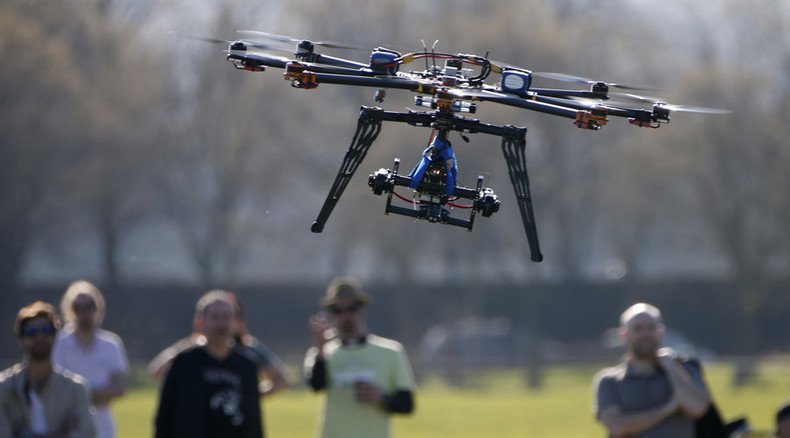US govt. secretly developing microwave drone interception system – sources to Reuters

The issue of increasing and unsanctioned drone flights is happening faster than the US government is developing legislation. Sources familiar with the matter say it’s now working on high-tech systems to catch and disable the devices.
The government, together with unnamed agencies, tried to field-test a microwave-based system in Times Square last year, according to anonymous sources speaking to Reuters. The idea was to intercept a freely available commercial drone and send it back to the owner. But it failed due to interference from nearby radio and TV broadcasts.
The counter-drone system would ideally track and identify the drone, then using a strong enough signal disrupt the drone’s own radio transmission.
The issue has been getting more urgent: over the last year, incidents of drones’ near collisions with aircraft and other potentially dangerous scenarios have soared – not to mention their usefulness in transporting illegal substances, as the case with Mexico’s drug trade proved; or small drones getting in the way of rescue and firefighting operations, as happened in California.
California county offers $25k for data on drone operators who interfered with firefighters http://t.co/famgerphxApic.twitter.com/73SZ0i74lv
— RT America (@RT_America) July 29, 2015There is also a danger of unsanctioned drones being used for malicious targeting or as weapons. Plenty of YouTube drone aficionados have been proving how easy it is to weaponize a commercial drone.
The sightings are increasing dramatically. As of August 9, US commercial pilots say they have spotted 650 so far this year, which is more than double the 238 during the whole of 2014. The situation is mirrored by sales. According to the Consumer Electronics Association, more than a million are expected to be sold this year – again, more than double last year’s sales, and more than seven times the year before that.
According to the sources, there will be an interagency effort to tackle the problem involving the Department of Homeland Security, the Federal Aviation Administration and the Defense Department. The interagency approach was revealed by the DHS, while the NYPD, FAA and DoD declined to comment.
Several problems have been faced by the government in recent years. Among the bigger issues is that regulations aren’t catching up fast enough, and there is also a bureaucratic hole around the use of commercial small-sized drones. In 2012, Congress decided the FAA was no longer going to oversee recreational drone use.
Drone sightings by aircraft pilots more than double since 2014 – FAA http://t.co/wns5ZB1YRapic.twitter.com/p3tYHzFKX3
— RT (@RT_com) August 14, 2015Some practical power to enforce the laws was needed, and so came the initiative with the microwave-based system. The idea behind field-testing in a crowded place was to see if law enforcement could safely steer the drone away from a potentially hazardous situation involving people, and land it back in its place of origin, also identifying the operator in the process.
Counter-drone efforts have so far been largely unsuccessful, as Reuters found out: only one in 10 cases have led to the perpetrators being identified, while a mere two percent of cases resulted in the law being enforced on the guilty parties.
At present authorities can’t just “shoot it out of the sky,” as one source told the news agency. “We have to come up with something that's kind of basic technology, so that if something happens, the drone or device will just go right back to the operators. It won't crash," they added.
“You need enough power to override the transmitter. If I just jam it so it can’t receive signals, it’s probably going to crash. But if I know the transmission codes the drone is using, I can control that object,” electronic warfare expert and retired marine, Lieutenant Colonel Muddy Watters, told Reuters.
Another idea being tossed around is using so-called ‘geo-fensing’, so the drone won’t stray into an area it’s not supposed to, or fly at a forbidden altitude. The Chinese manufacturer SZ DJI Technology Co Ltd, whose drone gave everyone a scare when it landed on the White House lawn in January, has now released a fix that prevents it from going into no-fly zones.
Google, NASA work together to design drone air-traffic-control system http://t.co/rx5Vf77Bijpic.twitter.com/Yfo56LYMnp
— RT (@RT_com) July 25, 2015Google and NASA are lending their weight to the numerous efforts now being undertaken to bring drones under control. They are working on a drone-age system resembling air traffic control. Many companies want to get onboard with this. The space agency and the tech giant are hoping to have the system up and running within 10-15 years.
And the US isn't alone. The Russians are in the process of developing a ray-gun for bringing down unmanned aerial vehicles - particularly the serious, weaponized kind, according to Sputnik. The federal space agency Roskosmos is taking part in the development of the so-called 'microwave gun', the name that's being thrown around at this time. When ready, the device could potentially knock out a drone's electronics at a distance of up to 10km.
LISTEN MORE:












